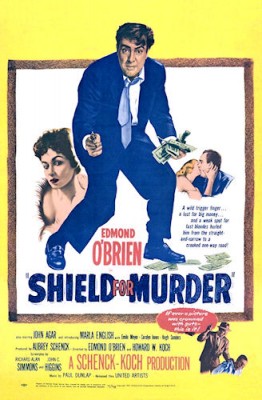| Reviews & Columns |
|
Reviews DVD TV on DVD Blu-ray 4K UHD International DVDs In Theaters Reviews by Studio Video Games Features Collector Series DVDs Easter Egg Database Interviews DVD Talk Radio Feature Articles Columns Anime Talk DVD Savant Horror DVDs The M.O.D. Squad Art House HD Talk Silent DVD
|
DVD Talk Forum |
|
|
| Resources |
|
DVD Price Search Customer Service #'s RCE Info Links |
|
Columns
|
|
|
Shield for Murder
Barney's crime is quickly suspected. Packy hires private detectives Fat Michaels (Claude Akins) and Laddie O'Neill (Lawrence Ryle) to intimidate Barney's girl, Patty Winters (Marla English), sending the supremely jealous Barney into a rage. In O'Brien's best scene in the picture, he viciously beats the two men almost to death in a coffee shop. A prostitute (Carolyn Jones) he's picked up is horrified by his behavior. (The camera smartly focuses on the reactions of the various patrons.)
Barney's devoted, up-and-coming partner, Sgt. Mark Brewster (John Agar), whom Barney pulled out of the gutter when Mark was a young punk with no future, recognizes Barney's mental unraveling and fears this father figure may have stolen the dough.
While television shows like Dragnet presented cops as incorruptible bastions of society, movies of the ‘50s were often much more cynical. Private Hell 36 and Rogue Cop covered similar territory that same year, conventional movies for the most part that nevertheless paved the way for Orson Welles's great masterpiece of police corruption, Touch of Evil, four years later.
Shield for Murder is, primarily, a vehicle for Edmond O'Brien, but as his character murders a man in cold blood in the opening scene, he doesn't engender any sympathy or even much understanding, nor does his subsequent possessiveness of Patty. He's fed up hunting down L.A. low-life and feels he's due a piece of their action. He dreams of a buying a suburban ranch house in the Valley with all the fixings, but he's so controlling and obsessive about her - a plot device not really necessary - that it's obvious their relationship would never last even under the best of circumstances.
What's most interesting about the picture is watching John Agar as Barney's disciple trying to come to terms with the realization that the man who saved him has gone sour and can't even save himself. Producer David O. Selznick discovered Agar while the latter was dating former child star Shirley Temple. Agar and Temple married soon after, and Agar landed choice roles in major films: Fort Apache (1948), She Wore a Yellow Ribbon, and Sands of Iwo Jima (both 1949) among them.
A messy, public divorce from the much-adored Temple, attributable mainly to Agar's alcoholism, caused a significant career decline for the actor from 1950 onward. Relegated to B-movies, he appeared in second-feature Westerns and crime films and, eventually, became strongly associated with the science fiction and horror genres, starring in, among others: Revenge of the Creature, Tarantula (both 1955), The Mole People (1956), Daughter of Dr. Jekyll (1957), Attack of the Puppet People, The Brain from Planet Arous (both 1958), Invisible Invaders (1959), Journey to the Seventh Planet, and Hand of Death (1962).
By the 1960s, he alternated between starring roles in increasingly threadbare sci-fi and horror films, and supporting parts in bigger productions, mainly Westerns, including several with his old friend John Wayne (The Undefeated, Chisum, Big Jake). Like many of his generation, Agar was in his old age embraced by a generation of genre fans, appearing at conventions and in films of varying quality, including a small but memorable role in Miracle Mile (1989). He died in 2002.
Agar was not a good actor. The video file of it seems to have vanished from the Internet, but one of the most sidesplittingly hilarious anecdotes I've ever heard was director John Frankenheimer discussing directing Robert Newton and Agar in a live television adaptation of The First and the Last, with alcoholic Agar nervously confessing to Frankenheimer that he was no actor. ("I wanted to say ‘No shit!'" said Frankenheimer.)
He tended to overact while appearing stiff and inexpressive simultaneously, over-enunciating his Midwestern drawl. But in Shield for Murder Agar is unexpectedly excellent, subtle in his performance as he very rarely was. Almost certainly actor O'Brien, who ran the gamut himself from superb to unpardonably hammy, coached him. (Koch, one would guess, probably supervised the camera and lighting for scenes featuring O'Brien, while O'Brien concentrated on the performances, which are uniformly good.) Watching movies like The Mole People and Invisible Invaders one would never have guessed that Agar was capable of such work, but here shows another direction his career might have taken.
Video & Audio
Kino's Blu-ray of Shield for Murder, licensed from MGM, is presented in widescreen, as it should be. (The film was released in the summer of 1954 by United Artists, by which time precious few American films were still being shot and projected "flat.") The image is a little bit washed out and a hairline less detailed than other similar black-and-white titles on Blu from this period, but it's certainly acceptable. The Dolby Digital mono is fine, and the disc is region A encoded.
Extra Features
The lone extra is a trailer, which without disclosing such is textless and missing narration.
Parting Thoughts
Familiar but not bad, Shield for Murder is mildly Recommended.
Stuart Galbraith IV is the Kyoto-based film historian largely absent from reviewing these days while he restores a 200-year-old Japanese farmhouse.
|
| Popular Reviews |
| Sponsored Links |
|
|
| Sponsored Links |
|
|
| Release List | Reviews | Shop | Newsletter | Forum | DVD Giveaways | Blu-Ray | Advertise |
|
Copyright 2024 DVDTalk.com All Rights Reserved. Legal Info, Privacy Policy, Terms of Use,
Manage Preferences,
Your Privacy Choices | |||||||














